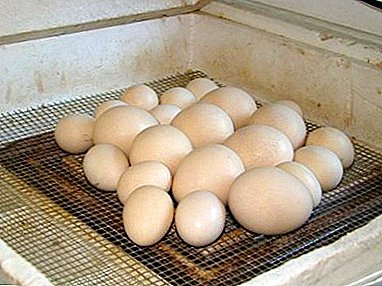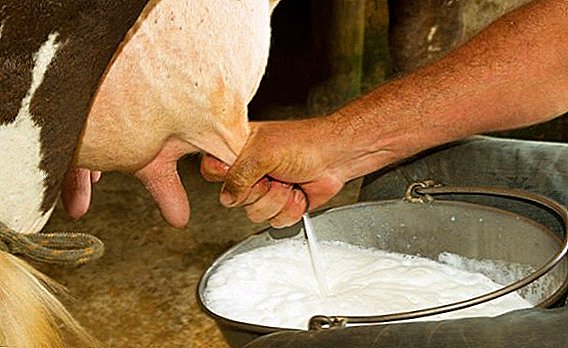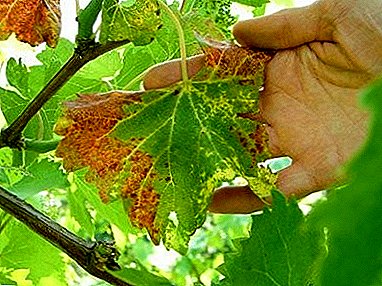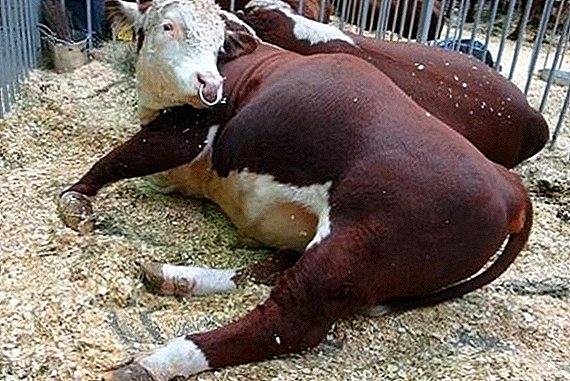 Breeding cattle is associated with the risk of infectious and non-communicable diseases, which occur quite often both in large cattle farms and in small farms. Knowing the symptoms of the most common diseases will allow you to recognize the disease in the early stages and prevent infection of the entire herd. This article describes the symptoms, treatment and prevention of pasteurellosis in cattle.
Breeding cattle is associated with the risk of infectious and non-communicable diseases, which occur quite often both in large cattle farms and in small farms. Knowing the symptoms of the most common diseases will allow you to recognize the disease in the early stages and prevent infection of the entire herd. This article describes the symptoms, treatment and prevention of pasteurellosis in cattle.
What kind of disease?
Pasteurellosis is a contagious infectious disease to which domestic and wild animals are susceptible. The causative agent of this disease is Pasteurella multocida (sometimes P. haemolytica).
Pasteurella is on the mucous membranes of the gastrointestinal tract (GIT) of animals, but the disease develops only in weakened, not vaccinated animals.
Once in the blood, the bacterium spreads through the body and causes swelling, inflammation, and hemorrhages in various organs: lungs, pleura, intestines, and joints.
Young animals are considered to be the most susceptible to infectious diseases, because in the first days after birth, calves do not have complete immune protection. In cattle, outbreaks of pasteurellosis are more common in summer and early autumn — in July, August, and September.
Did you know? Louis Pasteur received a pure culture of the pathogen and for the first time tried to make a killed vaccine. In his honor in 1910, this microorganism was named Pasteurella.
 This disease leads to large losses when released into large-scale livestock farms, as it leads to mortality and slaughter of livestock, treatment costs.
This disease leads to large losses when released into large-scale livestock farms, as it leads to mortality and slaughter of livestock, treatment costs.Causes and pathogen
The causative agent of Pasteurella multocida pasteurellosis is an aerobic bacteria. Microscopic culture can be seen short oval sticks, arranged in pairs or chains.
These are immovable bacteria, gram-negative when stained. Pasteurella have a low resistance, because they do not form a spore: they can be found in manure for 2-3 weeks, and in the corpses they persist for 3-4 months.
These bacteria quickly die under the action of sunlight and many disinfectants. Sources of infection of cattle can be any sick animals (pigs, horses, cows) and pasteurella carriers.
Often disinfection is carried out using the drug "Brovadez-plus."
 Carriers are not sick individuals that were kept next to the sick. In some farms the pastern can carry up to 70%. Cows that have been exposed to sick animals can be a source of infection for a year.
Carriers are not sick individuals that were kept next to the sick. In some farms the pastern can carry up to 70%. Cows that have been exposed to sick animals can be a source of infection for a year.The spontaneous incidence of pasteurellosis contributes to changing conditions of housing, moving or transporting livestock, as this can weaken animals.
Important! Often, pasteurellosis develops as a result of autoinfection in prosperous farms — with a decrease in the immunity of pasteurella, which is found in the carrier’s body, enters the bloodstream and infects internal organs.
Sick animals secrete the pathogen with feces, urine, saliva, milk, and coughing. Cows can get sick from contact with care products, manure, feed, and water. Infection can also occur through damaged skin, for example, when bitten by rodents or blood-sucking insects.
Bacteria get on the mucous membranes of the gastrointestinal tract and respiratory tract or directly into the blood (scratches, bites of animals and insects). 
Symptoms of manifestation in various forms
The incubation period lasts up to 2-3 days, and when released directly into the blood through damaged skin, the disease develops in a few hours. The duration of the disease can vary and depends on the immunity of the animal, the virulence of the bacteria, the conditions of the livestock, associated diseases.
Often, pasteurellosis occurs in conjunction with salmonella, diplococcosis, parainfluenza and adenovirus infection. Depending on the duration of the disease and the rate of development of symptoms, there are acute, super-acute, sub-acute and chronic forms of the disease.
Did you know? Infections with pasteurellosis can also occur through contact with wild animals. Even cats can be spreaders of pasteurella.
Sharp
In the acute course of a cow, the temperature is increased to 40-42 ° C. The animal becomes sluggish and eats worse. Milk secretion stops. In some cases, mastitis develops.
Against the background of fever, edema of the pharynx and oral cavity appears (edematous form). Breast form of pasteurellosis of cattle is characterized by the predominance of symptoms of respiratory failure, which appears on the background of lobar pneumonia, and a violation of swallowing.  A sick cow breathes often and hard, can be a dry cough. In young animals, intestinal form develops in most cases. An admixture of flakes and blood appears in the watery stools.
A sick cow breathes often and hard, can be a dry cough. In young animals, intestinal form develops in most cases. An admixture of flakes and blood appears in the watery stools.
Sometimes nasal bleeding, inflammation of the conjunctiva of the eyes and blood in the urine begin. Intoxication, respiratory disorders and cardiac activity lead to death in 2-3 days.
You will probably be interested in reading about the main diseases of cows and methods of their prevention.
Subacute
The subacute course is characterized by the development of pleuropneumonia, inflammation of the joints (arthritis) and nasal mucosa (rhinitis). Against the background of fever cough, mucous or mucopurulent nasal discharge appears.
Bloody diarrhea can begin at the end of the illness. The disease is fatal after 3-5 days.
Super sharp
In hyperacute course, symptoms of the chest form of the disease develop rapidly. The temperature rises to 41 ° C, begins inflammation of the vocal cords and pharynx. This is manifested by heavy breathing, coughing.  Swollen neck and maxillary region. In some cases, bloody diarrhea may occur. Animals die within 12 hours of the day due to asphyxia or pulmonary edema.
Swollen neck and maxillary region. In some cases, bloody diarrhea may occur. Animals die within 12 hours of the day due to asphyxia or pulmonary edema.
In some cases, death occurs suddenly due to acute heart failure before the onset of clinical manifestations of the disease. In septic form, the rapid death of the animal occurs on the background of diarrhea and high fever.
Chronic
For the chronic course of the disease is characterized by less pronounced disorders of respiration and digestion. Prolonged diarrhea (frequent, fluid excrement) leads to weight loss and exhaustion.
Pneumonia develops slowly. Gradually, swelling of the joints. With this course of the disease, the animals die in a few weeks. 
Diagnosis of the disease
The diagnosis is made based on the analysis of data on the incidence of pasteurellosis of cattle in the region, based on the development of symptoms in sick cows. Be sure to conduct an autopsy of dead cattle to assess structural changes in the tissues.
For microscopic and bacteriological studies, samples of parenchymal organs and blood are taken.
Pathological changes in organs depend on the course and form of the disease. In acute and hyperacute development of the disease, multiple hemorrhages are found in the heart and liver.
Inflammatory changes in the lungs, edema of the organs, and foci of necrosis in the kidneys and liver are characteristic of the chronic course of the disease. Bodies of dead animals are taken for research no later than 3-5 hours after death.  In hot weather, samples should be preserved with 40% glycerin before transportation. Nasal mucus and blood are collected from pasteurellosis in calves and adult cows.
In hot weather, samples should be preserved with 40% glycerin before transportation. Nasal mucus and blood are collected from pasteurellosis in calves and adult cows.
Laboratory diagnosis is:
- examination of blood smears under a microscope;
- the allocation of culture in special environments;
- infection of laboratory mice and rabbits with culture grown in a nutrient medium;
- determining the degree of virulence of the pathogen.
Treatment of pasteurellosis in cattle
Sick cows are isolated in a warm, dry room. During treatment, it is important to provide the animal with good nutrition. Intravenous and intramuscular injection of antibiotics, which are sensitive pasteurella: tetracycline, nitox, chloramphenicol, streptomycin and sulfa drugs.
In the treatment of pasteurellosis in animals using drugs such as: "Nitoks", "Lozeval" and "Tromeksin".Hyperimmune sera against bovine pasteurellosis are used for treatment. Additionally, intravenous glucose solution and saline solution are administered. The introduction of serum begins when the first symptoms of the disease appear.
A good therapeutic effect is given by the combined intravenous administration of a double prophylactic dose of serum and long-acting antibiotics. Sick animals for 6-12 months have good immune protection against pasteurellosis. 
Did you know? Some calves born to problem farms have a natural immunity to pasteurella. Their immunity is not always inherited from mothers, but is passed on through a generation.
Preventive measures
Important for the prevention of pasteurellosis is the observance of sanitary rules for the maintenance and care of livestock, because it helps to improve the immunity of cows. When revealed in a herd of pasteurellosis, non-diseased livestock must be vaccinated.
After the introduction of the precipitated vaccine twice, immunity is formed, which persists for 6 months. A single injection of emulsified vaccines provides Pasteurella immune protection for a period of at least one year.
As a preventive measure, serum is administered to young animals in the first days of entering the farm. Adults need to be vaccinated before transport. New animals are placed in a quarantine room for 30 days and conduct daily inspection.  Taking into account the possibility of infection by rodents and blood-sucking insects, it is necessary to make prophylactic vaccinations once a year. For the prevention of mass infection, it is necessary to conduct regular inspections of the entire cattle population.
Taking into account the possibility of infection by rodents and blood-sucking insects, it is necessary to make prophylactic vaccinations once a year. For the prevention of mass infection, it is necessary to conduct regular inspections of the entire cattle population.
Important! It is recommended to place only vaccinated cows in cattle-breeding complexes.
The premises in which the diseased animals were kept are disinfected. Disinfection should be carried out with a solution of bleach, which contains at least 2% active chlorine, 2% sodium hydroxide solution, 3-5% hot creolin solution, 1% formaldehyde solution.
The treatment of the premises is repeated every 10 days until the quarantine is removed. Quarantine is stopped 14 days after the completion of the treatment of sick animals and the vaccination of all contact and healthy animals.
The clothes of the staff who cared for sick cows during the treatment period must be carefully decontaminated. For this, things are boiled in 2% soda solution or soaked in 1% chloramine.  Rubber shoes are immersed in 5% chloramine for 2 hours. Dead bodies must be disposed of by incineration. Manure is disinfected with a solution of bleach.
Rubber shoes are immersed in 5% chloramine for 2 hours. Dead bodies must be disposed of by incineration. Manure is disinfected with a solution of bleach.
In farms where cases of pasteurellosis have been identified, a number of restrictive measures are being introduced:
- it is forbidden to regroup, import and export animals;
- surgical manipulations and vaccination against other diseases cannot be performed;
- it is forbidden to take out inventory, food, care items;
- trade in milk from sick cows is strictly prohibited.
In order to protect your cows from disease, follow the rules of caring for livestock, carry out preventive measures and buy animals only in prosperous agricultural complexes.
Pay special attention to regular inspections of young and adult cows. Remember the important rule: prevention of cattle diseases is cheaper than their treatment.












